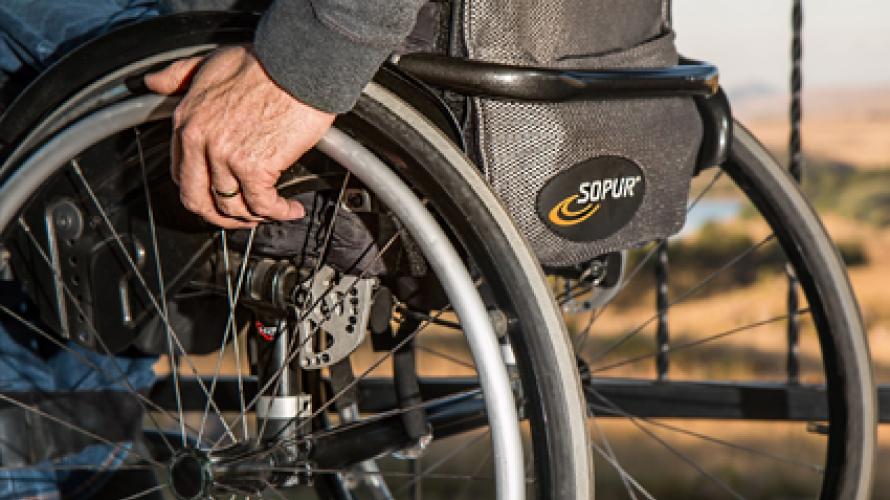Are you looking for ways to keep your wheelchair in the best condition?
From regular maintenance to cleaning tips and emergency repairs, you need this complete guide on maintaining your mobility device. Make sure to keep your wheelchair running smoothly so you can have worry-free independence.

The importance of regular maintenance for your wheelchair cannot be overstated. Keeping your wheelchair in good condition will not only ensure that it is safe to use, but also that it continues to provide you with an efficient and comfortable ride. Without proper maintenance, the life of your chair can be significantly shortened, leading to premature wear and tear and costly repairs. Regular maintenance checks are especially important if you use a manual/power or sports wheelchair, as these chairs require more constant care than standard manual wheelchairs.
This guide provides an overview of the types of regular maintenance needed for any type of wheelchair. It explains the types of inspection and cleaning steps required, as well as when and how often they should be done in order to maintain optimal performance. By following these steps periodically, you can help ensure that your wheelchair remains in peak condition for many years to come.
Brief overview of the importance of regular maintenance for wheelchairs
Maintaining a wheelchair is an important part of keeping it in good working order. Regular maintenance can ensure that all components are functioning properly and minimize premature wear and tear, which can lead to costly repairs. While it is possible to save money by performing your own wheelchair maintenance, the level of complexity involved may require the expertise of a professional technician. This guide provides an overview of the key aspects that should be taken into consideration when performing regular maintenance on your wheelchair.
Regular cleaning should be done with warm, soapy water and a soft cloth or sponge. Be sure to avoid using degreasers or harsh chemicals as this may damage the finish on some metals. Grease and oil buildup should also be avoided, as they can lead to a build up of dirt and debris that will reduce the performance of your wheelchair.
The tires are another important aspect of regular maintenance for wheelchairs, as flat spots or excessive wear can cause problems with both performance and safety. Check the inflation levels according to manufacturer recommendations and make sure the tires have adequate treads for better maneuverability over various surfaces or terrains. If you take your wheelchair off-road or on rugged trails often, make sure you use higher-treaded tires designed for rough terrain when necessary.
Wheelchair frames should also be inspected periodically for signs of looseness or misalignment in any pivot points such as caster forks butts and post heads that might increase risk of tipping over backwards if subjected to rough terrain operations etc. All welds should also be checked for cracking or imperfections that could cause sudden failure during operation. Any worn parts like nuts bolts springs shock absorbers etc should be replaced immediately. Additionally frame rusting must also kept in check, especially if you live near salty climates. If necessary apply rust preventive paint at regular intervals.
Finally, it’s wise practice to lubricate all moving parts with high quality lubricants at least twice a year.
Importance of having a well-functioning wheelchair
Having a well-functioning wheelchair is essential for those who use them on a regular basis. A wheelchair should provide its user with the highest degree of comfort, convenience, and mobility. Regular maintenance helps to ensure its safe operation and helps maintain its value over time.
Wheelchairs are considered medical equipment, so they need to be regularly serviced according to manufacturer guidelines. This will help prevent breakdowns, reduce mechanical failure and decrease the likelihood of an accident or injury related to unsafe operation. Having your wheelchair properly serviced is especially important if you use it on an incline or outdoors in off-road conditions.
Garages that specialize in wheelchair repairs can be found online or in person in most areas. They offer a wide range of services such as general cleaning, lubrication and part replacement as necessary for safe operation of your device. Most offer detailed inspections that can detect worn parts; these inspections should be done annually to ensure optimal performance from your wheelchair. Additionally, garages are also well-equipped to provide other services such as fitting new accessories or modifying seating systems if needed.
Trustworthy technical experts can provide advice on selecting appropriate mobility aids such as walkers, scooters and crutches; they may even be able to custom order components if needed for older wheelchairs. Investing in professional care for your device pays off in improved functionality over time and reduces the risk of costly repairs down the road caused by neglected care and maintenance needs.
Common Wheelchair Issues
Regular maintenance of a wheelchair can help to prevent many common issues. To ensure that your wheelchair operates properly, it is important to check for the following issues on a regular basis:
- Wheels: Make sure that the wheels are securely tightened and that the casters rotate freely. If you experience any wobbling, it is likely due to loose or worn wheels and should be addressed as soon as possible.
- Brakes: Ensure that the brakes are not too tight or too loose, and that they lock securely when applied. If they’re not adjusted correctly, you may be unable to stop quickly enough if you experience unexpected obstacles or terrain changes.
- Cushions and Seating: Check for wear, fading and tears in your cushions or upholstery on a regular basis. Proper posture is an integral part of maintaining optimal wheelchair function, so make sure you replace worn-out components promptly.
- Tires: Keep an eye on the treads of your tires; if they become worn down from frequent use or from being left out in wet conditions for long periods of time, replace them to avoid accidents caused by slippery surfaces or uneven terrain.
5 Tune-Ups: Conducting periodic tune-ups on your wheelchair is good practice in order to ensure proper functioning and safety while using it in both indoor and outdoor settings. Recommended tune-up services vary by model; however, most include checking brakes, replacing worn parts and lubricating all moving parts regularly accordingerly with manufacturer specifications.
Effects of neglecting regular maintenance
Neglecting regular maintenance for your wheelchair can have serious consequences. Without proper maintenance, components on the wheelchair may become worn or broken, leading to a decrease in your chair’s overall performance. This can affect not only the lifespan of your chair but also your safety and comfort.

In addition to mechanical problems, failing to perform preventive maintenance on your wheelchair can also have an effect on its appearance. Unchecked dirt and grime buildup will result in a chair that looks old and worn-out, which can be embarrassing and unpleasant for both you and onlookers.
Both battery-powered wheelchairs require specific attention as over time their batteries will start to deteriorate, reducing their range and performance if left unchecked. Neglecting regular battery checks means you may not be aware of any problems with your battery or know when it needs replacing before it fails prematurely and leaves you stranded.
III.Regular Maintenance Checklist
One of the most important components of wheelchair ownership is maintaining your device regularly to ensure that it is functioning optimally. Taking the time to perform regular maintenance checks and services will help prevent breakdowns, provide extra mileage for your wheelchair, reduce repair costs, and extend the lifespan of your device.
To help ensure you are regularly servicing and maintaining your chair correctly, here is a list of items that should be checked monthly:
- Tighten bolts
- Check tire pressure
- Clean around wheel spokes
- Inspect battery function
- Test charger indicator light
- Tighten/inspect tie down straps
- Clean brake levers/cables
- Inspect footrests/accessories for wear/tear and stability
Depending on the type of wheelchair you own, there may be additional maintenance requirements. Be sure to read any specific instructions given in your owner manual or reach out to a trusted technician if you’re unsure about what routine checks should be performed.
Detailed checklist for maintaining a wheelchair
Keeping your wheelchair regularly maintained is essential for optimal function and longevity. To help ensure that your wheelchair remains in good working condition, it is important to follow a detailed maintenance checklist. This guide will provide an overview of what to check periodically and how to care for your wheelchair components.
Wheels: Proper functioning wheels are essential for the safe operation of a wheelchair. You should check your wheels regularly for any signs of damage or wear and tear such as frayed spokes, bent axles, or loose nuts/bolts. Be sure to also tighten the bolts holding the rear whcels and adjust them when necessary. Additionally, keep an eye out for uneven tire wear or flat tires and replace them if needed.
Wheelchair Cleaning and Storage
Regular cleaning and proper maintenance of your wheelchair is an important part of ensuring its durability and optimal usage. Not only does it keep the wheelchair comfortable and safe to use, but it also prevents damage, prolongs its lifespan, and helps to maintain the overall performance of the chair.
In order to best take care of your wheelchair, the following are essential steps you should take:
- Cleaning: Regularly clean the seat with a damp cloth and mild detergent so that debris does not accumulate on its surface. Wipe down inside components as well as other surfaces, paying particular attention to corner joints where dirt may be hiding. Make sure all wheels and casters are cleaned regularly as well for smooth performance over any terrain.
- Lubrication: After cleaning, lubricate regularly moving parts such as wheel hubs, brakes and axles using spray lubricant or lithium grease (do not use motor oil). This will ensure smooth movement over any terrain by preventing any wear or tear on components from too much friction or heat buildup during operation on different surfaces or inclines.
- Inspection: During regular cleaning sessions be sure to check for any loose bolts or nuts around the frame securing it in place. If you spot anything missing or broken then have a professional wheelchair technician assess it before next time you go out again with this device so as to further prevent any accidents that could result due to negligence in this regard.
- Storage: Always make sure your wheelchair is kept in a dry environment free from dust and debris that can create problems while traveling later on down the line. Be sure also to keep components such as batteries charged so they are always ready for travel when needed in case of an emergency – especially if you live in colder climates where temperatures can get below freezing during winter months making outdoor trips more difficult without back up power sources!
Importance of cleaning and storage for wheelchair maintenance
Cleanliness is an important part of wheelchair maintenance and longevity. Dust, dirt, and debris can cause a build-up of grime on the wheelchair’s components over time. This can lead to rusting and corrosion of the parts, decreasing their lifespan. It is important to regularly clean your wheelchair in order to ensure that it operates as efficiently as possible for as long as possible.

Start off by wiping down the surfaces with a soft cloth like microfiber. Be sure to pay special attention to any crevices where dirt or grime may have accumulated. After wiping everything down with a dry cloth, use a damp one with some mild soap-and-water solution to do more detailed cleaning. When you’re done, wipe down your wheelchair with a dry cloth again so that all moisture has been removed before continuing on maintenance tasks that require electricity.
In addition to cleaning your wheelchair regularly it is also important to ensure proper storage when not in use for long periods of time or for those who don’t use their wheelchairs daily like those living in nursing homes or assisted living facilities. When storing wheelchairs, keep them in climates where fluctuations in temperature will be minimal and there will be no chance of water entering the frame or joints and potentially causing rusting or corrosion which would shorten its lifespan significantly if left untreated. Additionally try to keep wheelchairs away from direct sunlight whenever possible so that fabrics don’t fade prematurely due.
Conclusion
When it comes to staying healthy and actively engaged in all of life’s activities, regular wheelchair maintenance is essential. Servicing your chair on a regular basis helps ensure that it is functioning optimally, providing the user with optimal capabilities, comfort, and performance. With proper and regular maintenance, you can extend the life of the wheelchair, improve its performance, reduce the risk of unexpected repair costs down the line—and most importantly—provide a safe ride for the user.
It is important to maintain a schedule for servicing your wheelchair and to inspect parts that may need replacement frequently. This includes checking for worn or damaged tires and wheels; ensuring all upholstery components are in good condition; cleaning all electrical connections; checking control systems; inspecting brake pads; and ensuring that clamping systems are secure. With regular inspection at home — along with services provided by an authorized service professional —you can rest easy knowing that your wheelchair is safe and reliable.
FAQs
What is the regular maintenance of a wheelchair?
Regular maintenance of a wheelchair includes checking the tires, brakes, bearings, upholstery, and frame for wear and tear, and ensuring that all parts are functioning properly.
What is the importance of adjusting wheelchairs?
Adjusting wheelchairs is important to ensure proper fit and comfort, prevent injury, improve posture, and maximize mobility.
How often does a wheelchair need to be serviced?
A wheelchair should be serviced at least once a year, but more frequently if it is used frequently or has been subject to heavy use or damage.
What is the single most important thing about using a wheelchair with a patient in it?
The single most important thing about using a wheelchair with a patient in it is ensuring their safety and comfort, and taking into account their individual needs and preferences.
How do you clean and maintain a wheelchair?
A wheelchair can be cleaned and maintained by wiping down the frame and upholstery with a damp cloth, checking and tightening any loose bolts or screws, and lubricating any moving parts.
What is the most important part of a wheelchair?
The most important part of a wheelchair is the seat, as it provides support and comfort to the user.
How the wheelchair should be cleaned and how often?
A wheelchair should be cleaned regularly, ideally after every use, by wiping down the frame and upholstery with a damp cloth and using a mild detergent if necessary.
What do wheelchair services provide?
Wheelchair services provide assessment, fitting, and maintenance of wheelchairs, as well as training on their proper use and adjustments.
What is a common problem on a wheelchairs?
A common problem on wheelchairs is the wearing down of tires or the malfunctioning of brakes or other parts, leading to reduced mobility or safety risks.
What are the needs of people in a wheelchair?
People in a wheelchair have a range of needs, including accessibility, mobility, comfort, safety, and independence, as well as support for activities of daily living and social participation.
See Also-
- Best lightweight wheelchair 2023
- Best power wheelchair for outdoor use 2023
- Best portable wheelchair ramp 2023
- Best manual wheelchair 2023
- Best electric wheelchair for heavy person 2023


